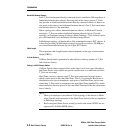
Preliminary
Cascade Topology
SANbox-16HA Fibre Channel Switch
5-6 Multi-Chassis Fabrics 59005-03 Rev. A Installer’s/User’s Manual
Cascade Fabric Size
SANbox-16 chassis connected in Cascade topology expand from two chassis to a
maximum of eight chassis. If you use Cascade-with-a-loop topology and cable
eight T_Ports on each chassis for chassis interconnection (four to each adjacent
chassis), this results in a maximum of 64 user ports. If you cable two T_Ports on
each chassis for chassis interconnection (one to each adjacent chassis), this results
in a maximum of 112 user ports.
If your fabric port requirements dictate the use of eight or more Switch chassis,
Multistage topology can result in more user ports than Cascade-with-a-loop
topology. Multistage topology is described later in this manual.
Cascade Latency
Each Chassis will route traffic in the direction of the least number of chassis hops.
A chassis will route traffic in the other direction if all links in the closest direction
fail.
Latency to any port on the same chassis is one chassis hop.
Latency to any port on adjacent chassis is two chassis hops (counting the source
chassis). This is the same latency as Mesh and better than Multistage. Multistage
has three hops to any other IO/T chassis.
Latency to any port on the second chassis away in either direction is three chassis
hops. This is worse than Mesh (for latency purposes, all chassis in Mesh are
adjacent chassis) and the same as Multistage.
Latency to any port on the third chassis away in either direction is four chassis
hops. This is worse than Mesh (for latency purposes, all chassis in Mesh are
adjacent chassis). At this point, a Multistage switch has less latency (three hops to
any chassis).
As you can see from the above, latency becomes more costly than other topologies
beyond five cascaded chassis. At five chassis, no destination is more than three
chassis hops away in the shortest direction (counting the source chassis).


















